An Introduction to CF Card
What Is a Compact Flash Card
A CF card (CompactFlash card) is a data storage card used in electronic devices. It was first introduced by SanDisk in 1994. This card is widely used in digital cameras, industrial equipment, and embedded systems. It is one of the earliest successful flash memory card standards.
The following are the basic features of CF cards:
- Size: 43mm x 36mm x 3.3mm (Type l) or 5mm (Type ll).
- Interface: It uses parallel ATA (PATA) and SATA interface (CFast).
- Capacity: The maximum capacity of common CF cards on the market is 512 GB.
- Voltage compatibility: Having strong adaptability, it supports 3.3V and 5V.
- Sturdy structure: It is shock-resistant and suitable for harsh environments.
What Is It Used for
The CF card can be used widely, especially in scenarios where it needs high performance. It is not only a storage medium for storing data, but also a core component of professional equipment.
- Professional photography: It is used to store high-resolution photos and RAW format images by high-end digital cameras. It supports high-speed continuous shooting and high-definition video recording.
- Video production: Movie cameras and broadcasting equipment use it to record 4K or 8k videos. And it is particularly suitable for high frame rate and high bit rate scenes.
- Industrial control system: Due to its shock and temperature resistance, it is used in embedded systems, PLC controllers, and automatic equipment as system boot disks or data recording media.
- Medical and scientific research equipment: It stores medical images, experimental data, etc., to ensure data security and stability.
- In-vehicle system: It is used in navigation, in-vehicle entertainment systems, data recorders, and other equipment.
- Embedded development and testing: As a storage module in the development board or single-chip system, it supports file systems such as FAT32. It facilitates data reading, writing, and transplantation.
Scenarios and Causes of CF Card Data Loss
As a professional-grade storage medium, although a CF card is highly stable, data loss may still occur in actual use.
In general, data loss is caused by a problem with the card, or the card itself remains intact but the files are missing. The following are some specific scenarios and reasons:
Human error:
- Formatting or deleting files by mistake: This is one of the most common reasons for data loss.
- Unsafe device removal: Abrupt removal of the CF card may cause file system corruption.
Logical error:
- File system corruption: Corruption in the file system structure can make data inaccessible.
- Virus or malware attack: Viruses and malware can corrupt files or make data unreadable.
- Power outage or write interruption: A sudden power outage while writing data may cause the file to not be saved correctly.
Physical damage: The CF card body is damaged or broken due to external factors.
What to Do When Data Loss Happens
When you discover data loss, remember the following warnings:
- Stop using the CF card immediately. Do not take photos, record videos, or write any new data to avoid overwriting. This will improve the recovery success rate.
- Safely remove the CF card. Safely eject the CF card from the device. It can avoid further damage due to a power outage or improper insertion and removal. Then, use a card reader to connect to the computer and ensure that the device can recognize the CF card.
- Confirm the type of loss. Is it accidental deletion, formatting, file system damage, or the device cannot be recognized?
- Try CF card recovery software to recover data. The sooner you recover, the higher the recovery success rate.
Step 1: Check if Your Files Are Hidden
Sometimes, Windows hides some files by default. If your files are hidden, it will create a false impression of data loss, so first show your hidden files.
Option 1: Via File Explorer
Step 1: Right-click the Windows button and choose File Explorer.
Step 2: In the top section, switch to the View tab and tick the box for Hidden items.
This will allow you to see hidden files that are grayed out.
Option 2: Via Control Panel
Step 1: Open File Explorer Options
Open the Control Panel and click File Explorer Options, or type File Explorer Options in the search box.
Step 2: Show hidden files
Select the View tab in the pop-up window, check Show hidden files, folders, and drives in Advanced Settings, and click OK.
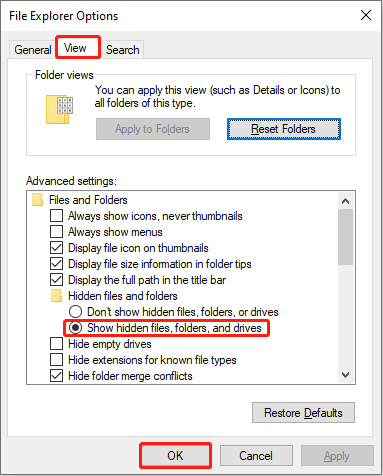
If you still can’t see the file after enabling Show Hidden Items, the file may have been deleted, damaged. Then, you need to do a CF card recovery.
Step 2: Perform a CF Card Recovery
Regardless of whether your card has a logical error or not, you need to recover data first. And then take measures to repair the card.
To recover lost data from your CF card, you can use the backups, try data recovery software, or ask for a professional service.
Way 1: Recover Data From Backups
If you have a backup of your CF card, then file loss is no longer a problem.
Option 1: Restore from local computer backup
If you have copied the data in the CF card to the computer’s hard drive or an external hard drive:
Step 1: Open the backup folder and find the corresponding photos, videos, or documents.
Step 2: Copy the files back to the CF card or other devices.
It is recommended to use a card reader to connect the CF card to avoid operating directly in the camera
Option 2: Restore from cloud backup (such as OneDrive, Google Drive, iCloud)
Step 1: Log in to your cloud service account.
Step 2: Search or browse the backup folder (such as “CF card backup”).
Step 3: Download the required files to the local or sync directly to the device.
Option 3: Restore using backup software
Many users may choose to use professional backup software for data backup because it is more efficient, secure and controllable. If you did so, restore files from it.
Way 2: Recover Data Using Data Recovery Software
It is a good choice using a powerful data recovery tool to do a CF card recovery. Which tool is trustworthy? The top suggestion is MiniTool Power Data Recovery.
This robust software can handle common data loss such as accidental deletion, formatting, file system damage, etc. And it allows recovery of a wide variety of file types.
It not only supports CF cards, but also SD cards, USB, HDD, SSD, and other devices. It is capable of scanning the drive marked as “unallocated” on the storage device and recovering files from it.
MiniTool Power Data Recovery runs in read-only mode during the recovery process and does not perform any write operations on the storage device.
It is simple to operate and efficient. Even if you are a novice, you can complete data recovery in a few steps. By the way, this free data recovery software allows you to recover 1 GB of data for free.
Download and install it to start a CF card data recovery.
MiniTool Power Data Recovery FreeClick to Download100%Clean & Safe
Step 1: Launch the software and scan the card
Launch MiniTool Power Data Recovery by double-clicking the icon. After loading all the disks, you will enter the main interface by default.
In the Logical Drives tab, all the partitions, including lost partitions, existing partitions, and unallocated spaces, are displayed. Next to it, the Devices section includes all the disks connected to your computer.
Now, find your CF card, move the cursor to it, and click Scan to scan for data.
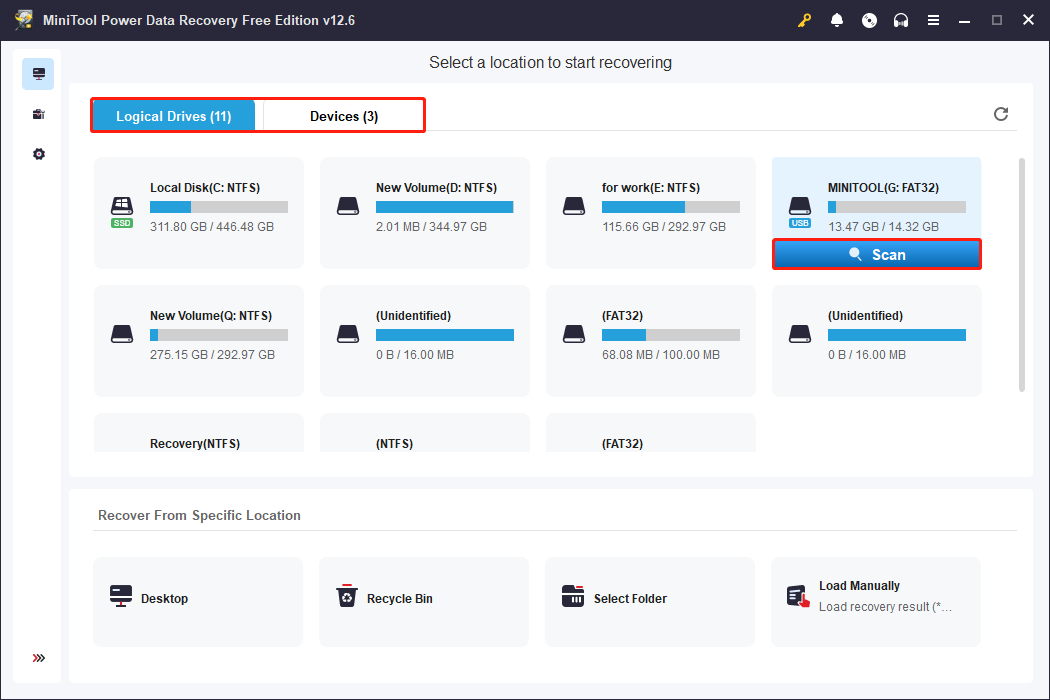
Step 2: Use features to locate the target files
After scanning, the results will be displayed in a tree structure based on the original path of the file.
You can expand the files layer by layer to view the files. It is suitable for you to use when you remember which folder the file was originally stored in.
- Type: Classify by file type, such as pictures, documents, videos, audio, etc., so that you can quickly locate a certain type of file.
- Filter: Can filter the scan results according to the following conditions: file type, modification date, file size, file category, reduce interference items, and improve search efficiency.
- Search: Very suitable for situations where you know the file name or part of the name. Enter the file name keyword and press Enter to quickly locate the target file.
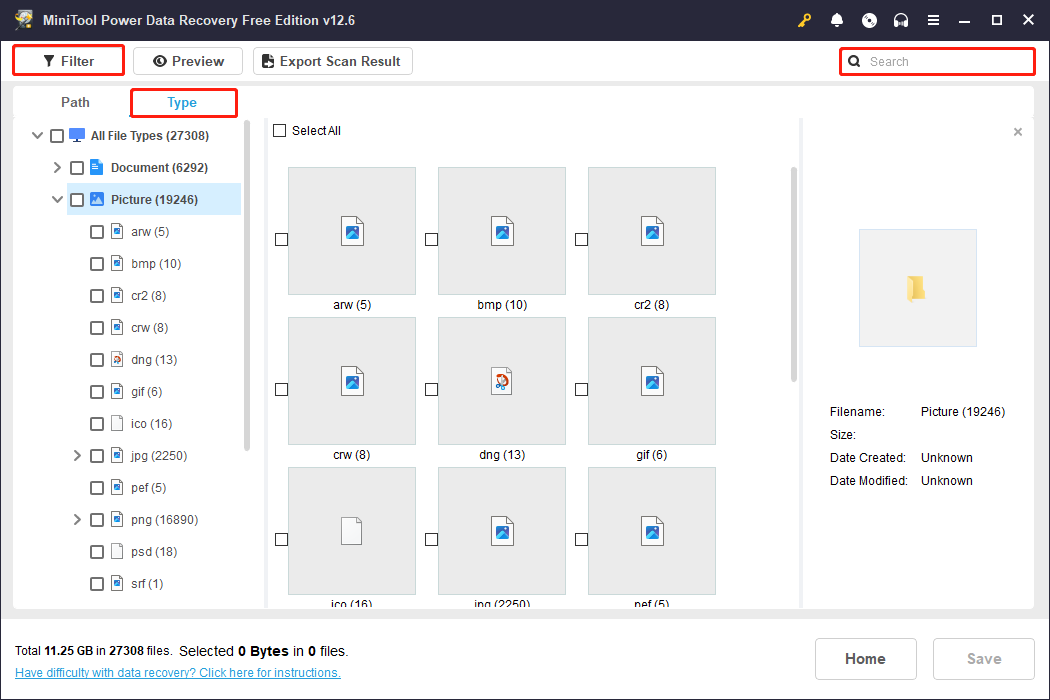
Step 3: Preview the file you have found
After finding the target files, check their contents first. It can guarantee the accuracy of the restoration. Select the target file and click the Preview button.
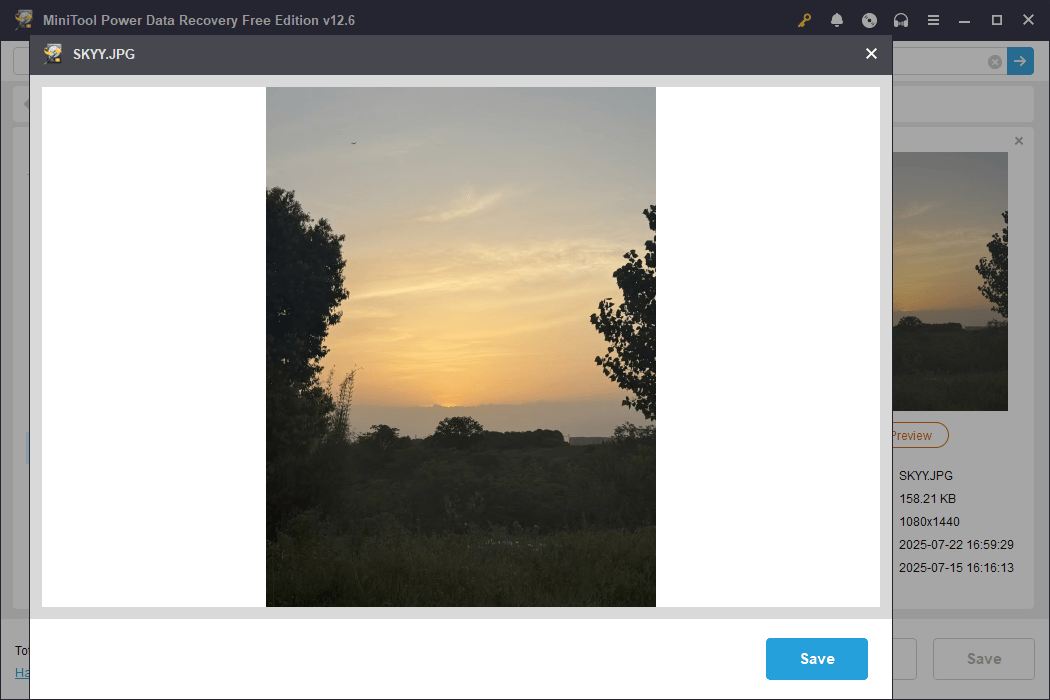
Step 4: Save files to a safe destination
After confirming the files, tick them all and click Save. There will be a window prompting you to choose a location. Choose a new and safe path for your recovered files and click OK. The compact flash recovery will start.
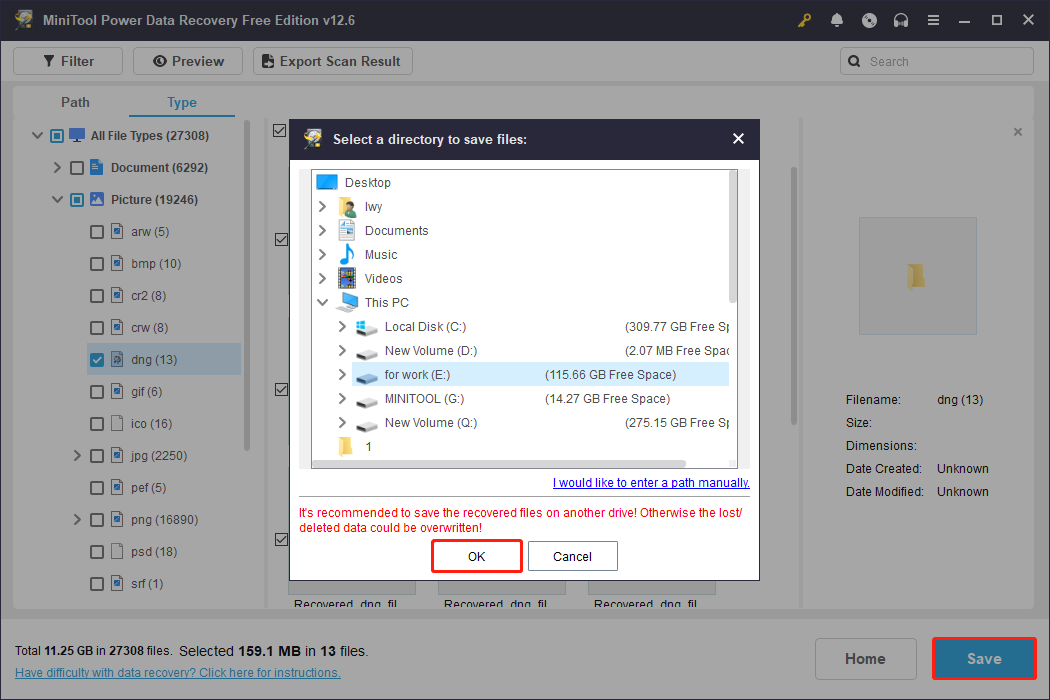
When the Recovery completed window shows, the CF card recovery is done. You can see the size of the recovered files and the remaining free recovery capacity.
Way 3: Seek for Data Recovery Service
If your CF card is physically damaged or the data cannot be recovered by software, you may need to seek professional data recovery services.
Compared with ordinary recovery software, professional services have a higher success rate, stronger technical support, and more complete security.
Professional institutions have advanced equipment (such as clean rooms) and experienced engineers. They can handle complex situations such as hard drive damage, RAID array failure, SSD chip failure, etc.
Step 3: Other Ways to Troubleshoot CF Card Issues
Now that you have recovered the data, you can proceed with troubleshooting the CF card to avoid further damage.
Fix 1: Run CHKDSK
When the disk is running abnormally, you can run CHKDSK with special parameters to find and fix errors on the disk.
Step 1: Open the administrative Command Prompt
Type cmd in the taskbar search box, right-click Command Prompt, and select Run as administrator. When prompted by UAC, click Yes to continue.
Step 2: Run the command
Type chkdsk G: /f /r /x in the window and press Enter. Replace G with the drive letter of your drive.

Here is what each letter means:
- G is the drive letter of the disk you want to check
- /f repairs errors on the disk
- /r scans bad sectors and attempts to recover readable information.
- /x forcefully dismounts the volume (if necessary)
Fix 2: Change the Drive Letter
If two disks use the same drive letter, the disk may not be recognized or accessed. So, change the drive letter.
Step 1: Press the Win + X keys and select Disk Management.
Step 2: Find the disk you want to change the drive letter to, right-click the disk area, and select Change Drive Letter and Paths.
Step 3: Click Change, select an unused drive letter, and click OK.
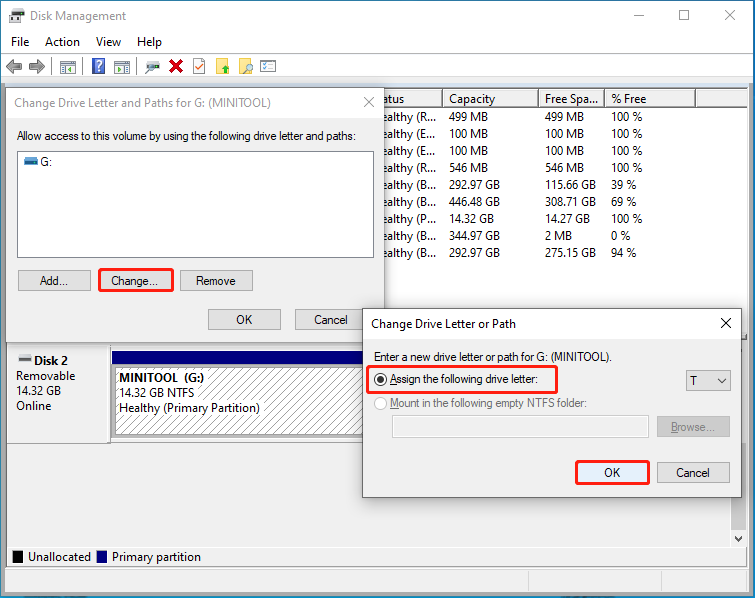
Fix 3: Update or Reinstall Driver
An outdated driver may affect your CF card. So, you can try updating or reinstalling it.
Step 1: Right-click the Windows button and choose Device Manager.
Step 2: Expand Disk drives, right-click your card, and click Properties.
Step 3: Switch to the Driver tab and click Update Driver.
Step 4: In the new window, select Search automatically for drivers.
If this didn’t take effect, try uninstalling the device.
Step 1: Also in the Driver tab, click Uninstall Device.
Step 2: Click Uninstall to confirm the operation.
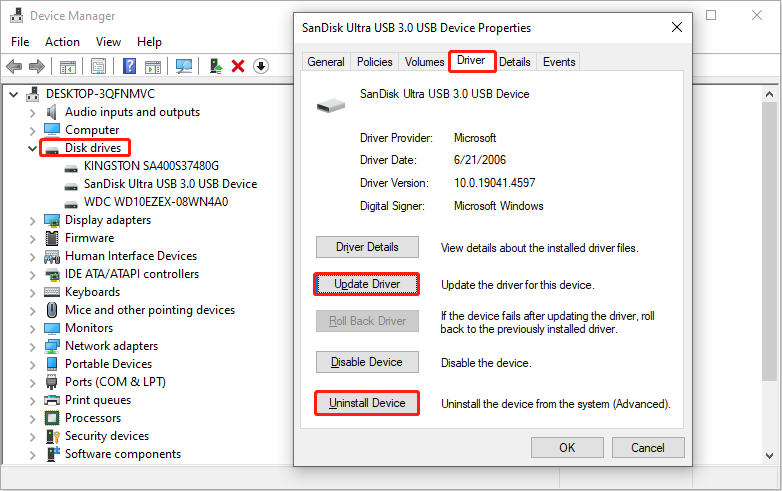
After that, restart your computer and Windows will install the new driver automatically.
Fix 4: Format CF Card
The last resort is to format the CF card. Although it will delete all data on your device, you have done a data recovery before.
Option 1: With File Explorer
Step 1: Right-click the Windows button and choose File Explorer.
Step 2: Click This PC, right-click your disk, and choose Format.
Step 3: Set file system, allocation unit size, and volume label, tick the Quick Format, and click Start. In the warning box, click OK to perform this operation.
Option 2: With Disk Management
Step 1: Press the Win + S keys, type Disk Management, and hit Enter.
Step 2: Scroll down the list to find your disk, right-click it, and choose Format.
Step 3: Set the volume label, file system, and allocation unit size, check the box for Perform a quick format, and hit OK. Click OK in the pop-up box to apply the change.
How to Protect Your CF Card
Proper protection of CF cards can extend their service life and prevent data loss and physical damage. Here are some practical suggestions.
1. Back up data regularly
Copy important data to a computer or cloud to avoid irreversible losses caused by card damage or misoperation. It is recommended to use a data backup tool.
2. Enable the write protection feature
If your CF card or card reader supports a write protection switch, turn it on to prevent accidental writing or deletion.
3. Use it correctly
- When removing the CF card, always use the Safely Remove Hardware feature to avoid file system damage.
- Do not suddenly turn off the power or remove the card during data reading and writing.
- Avoid continuing to write data when the storage space is full.
4. Keep it physically clean and safe
- Clean the metal contacts of the CF card regularly to avoid oxidation or poor contact.
- Avoid using it in high temperatures, humidity, strong magnetic fields, etc.
- Do not bend, squeeze, or drop the CF card.
More Information About CF Card
Now your task is completed. Here is some information about a CF card as a supplement.
Types of CF Card
CF cards can be classified from multiple dimensions, mainly including the following methods:
1. Classification by physical size
- Type l: 3.3 mm thick, the most common type, widely used in digital cameras and other devices
- Type ll: 5.0 mm thick, supports larger capacity, used for micro hard disks (MicroDrive)
Type ll slots are compatible with Type l cards, but not vice versa.
2. Classification by speed and protocol
- Standard CF card: uses PATA (parallel ATA) interface, with lower speed
- High-speed CF card: supports UDMA mode (such as UDMA7, up to 167MB/s)
- CFast card: uses SATA interface, faster speed (such as CFast2.0 up to 600MB/s)
- CFexpress card: uses PCle + NVMe protocol, with speeds of up to 2000MB/s, which is the most advanced CF card standard at present
3. Classification by application scenario
- Consumer-grade CF card: used for ordinary digital cameras, MP3 players, etc.
- Professional-grade CF card: used for SLR cameras, high-speed photography, industrial equipment
- Military/industrial CF card: with anti-vibration, dustproof, wide temperature, etc.
Advantages and Disadvantages
You must have known that CF card has the advantages of high speed, high stability, high security, durability, high compatibility, low power consumption, etc.
Now, let’s understand some of its shortcomings so that you can use it better.
- Large size: Compared with SD cards and microSD cards, CF cards are larger in size. And they are not suitable for thin and light devices.
- Pin damage: The 50-pin interface has a complex structure. Improper insertion and removal can easily cause the pins to bend or be damaged.
- Expensive: The price of high-end CF cards is much higher than SD cards. And some models even exceed the camera itself.
- Decrease in device compatibility: Modern consumer devices mostly use SD cards. And CF card slots are gradually being eliminated.
- Card reader support is required: Most computers do not have built-in CF card slots. They require additional equipment to read.
Differences Between CF Card and SD Card
The last part explains the difference between a CF card and a commonly used SD card.
1. Size and appearance
- CF card: Larger (about 42.8 x 36.4 x 3.3 mm), more durable.
- SD card: Smaller (standard SD is about 32 x 24 x 2.1 mm), more suitable for lightweight devices.
2. Speed and performance
- CF card: Usually has faster read and write speeds, suitable for professional photography and HD video recording.
- SD card: Speed varies by model, and high-end models can also meet most needs.
3. Capacity support
- CF Card: Supports up to 512 GB, ultra-large capacity, industrial-grade.
- SD Card: Currently, the maximum capacity of SD cards on the market is 2TB, with common capacities ranging from 32 GB to 1 TB.
4. Interface and compatibility
- CF card: Uses a pin interface, plug and unplug carefully, often used in professional equipment.
- SD card: Uses a contact interface, easy to plug and unplug, widely used in consumer electronics.
5. Price and popularity
- CF card: Relatively high price, mainly used in high-end equipment.
- SD card: Affordable, widely used, easier to buy.
6. Durability
- CF card: Strong shock and temperature resistance, suitable for harsh environments.
- SD card: Although there are also waterproof and dustproof models, the overall durability is slightly inferior.
Bottom Line
Now, you know how to recover lost CF card data. The backups, MiniTool Power Data Recovery, or a professional service are all your choices. Then, troubleshoot your CF card by running CHKDSK, updating drivers, or formatting.
If you have any questions about MiniTool products, feel free to contact us via [email protected].

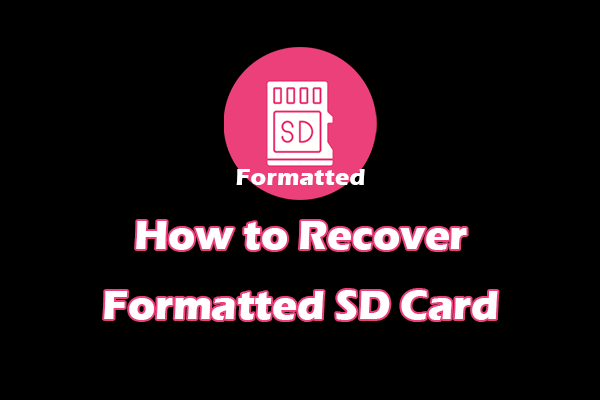
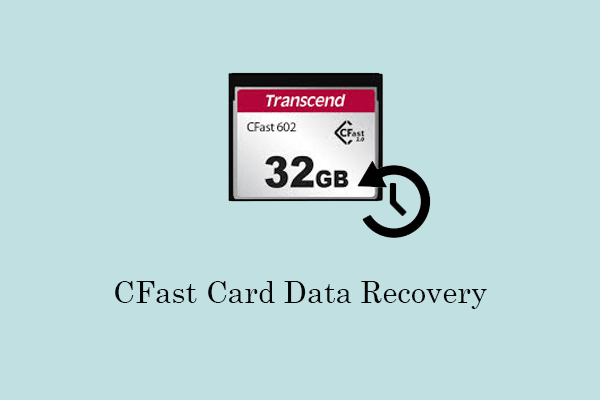
User Comments :